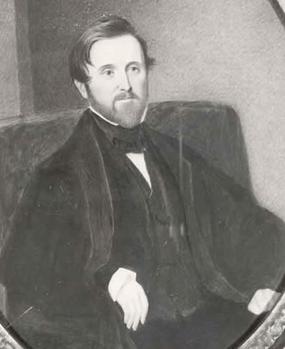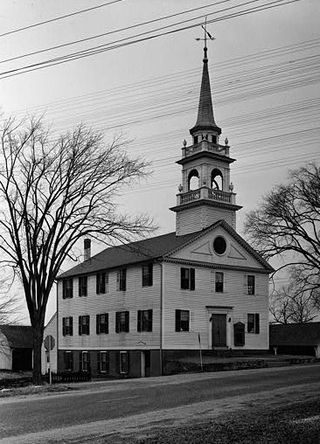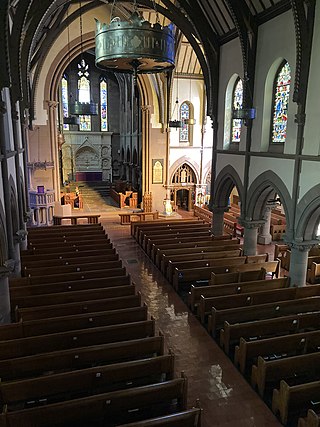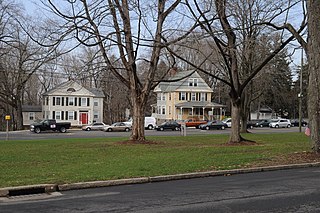
Bloomfield is a suburb of Hartford in Hartford County, Connecticut, United States. The town's population was 21,535 at the 2020 census. Bloomfield is best known as the headquarters of healthcare services company Cigna.

The New Haven Green is a 16-acre (65,000 m2) privately owned park and recreation area located in the downtown district of the city of New Haven, Connecticut. It comprises the central square of the nine-square settlement plan of the original Puritan colonists in New Haven, and was designed and surveyed by colonist John Brockett. Today the Green is bordered by the modern paved roads of College, Chapel, Church, and Elm streets. Temple Street bisects the Green into upper (northwest) and lower (southeast) halves.

Gibraltar Island is an island in Ohio, located within Lake Erie. This small 6.55-acre (0.026 km²) island is just offshore of South Bass Island. It is part of Put-in-Bay Township, Ottawa County, Ohio.

Alexander Jackson Davis, was an American architect, known particularly for his association with the Gothic Revival style.

Fort Griswold is a former American defensive fortification in Groton, Connecticut named after Deputy Governor Matthew Griswold. The fort played a key role in the early stages of the American Revolutionary War, in correspondence with Fort Trumbull on the opposite side of the Thames River. Griswold defended the port of New London, Connecticut, a supply center for the Continental Army and friendly port for Connecticut-sanctioned privateers who attacked British ships. The 17-acre site is maintained as Fort Griswold Battlefield State Park by the Connecticut Department of Energy and Environmental Protection.

Preston City is a village and the original town center of the town of Preston, Connecticut. The core of the village around the junction of Old Northwest Road and Route 164 is designated as the Preston City Historic District, a historic district that is listed on the National Register of Historic Places. The district is located along Old Shetucket and Amos Roads, which, prior to the 1930s, were major thoroughfares.

The Southport Historic District in the town of Fairfield, Connecticut is a 225-acre (91 ha) area historic district that was listed on the National Register of Historic Places in 1971. It preserves a portion of the modern neighborhood and former borough of Southport, Connecticut. Since the British burnt almost all of Southport's structures in 1779, there is only one home built prior to that date, the Meeker House at 824 Harbor Road, which survives.

Oliver Dwight Filley was an American businessman, abolitionist, and politician who served as the 16th mayor of St. Louis, Missouri from 1858 to 1861.

Ampere, formerly known as The Crescent, is a defunct stop on New Jersey Transit's Montclair-Boonton Line in the city of East Orange, Essex County, New Jersey, United States. A station was first built there in 1890 to service to new Crocker Wheeler plant in the district. The stop was named in honor of André-Marie Ampère, a pioneer in electrodynamics and reconstructed as a new Renaissance Revival station in 1908. Ampere was the second stop on the branch west of Newark Broad Street Station until 1984, when the Roseville Avenue station was closed. In June of that year, the station, along with 42 others, was entered into the National Register of Historic Places. In 1986, after continuous deterioration, New Jersey Transit demolished the westbound shelter built in 1921. The agency discontinued rail service to Ampere on April 7, 1991. The entire station was demolished in 1995.

St. John's Protestant Episcopal Church is an historic church located at 628 Main Street in Stamford, Connecticut. The church is an English Gothic Revival structure, built in 1891 to a design by William Potter. It has buttressed stone construction, with a compound-arch entry and a large rose stained-glass window. The associated parish house, also a Gothic Victorian structure, was designed by Richard M. Upjohn and built in 1869–72.

The Stone Plantation, also known as the Young Plantation and the Barton Warren Stone House, is a historic Greek Revival-style plantation house and one surviving outbuilding along the Old Selma Road on the outskirts of Montgomery, Alabama. It had been the site of a plantation complex, and prior to the American Civil War it was known for cotton production worked by enslaved people.
Liberty Green Historic District is a local historic district in the town of Clinton, Connecticut, and Liberty Green is a triangular town green within it. The district was created in 1979 following a lengthy study, report and enabling ordinance

The Washington Street Historic District encompasses a residential area of Middletown, Connecticut that has a long history as a fashionable and desirable neighborhood. Extending along Washington Street and Washington Terrace between Main and Jackson Streets, the area has a broad diversity of residential architecture dating from 1752 to 1931, reflecting the city's patterns of growth. The district was listed on the National Register of Historic Places in 1985.

The Davis County Courthouse in Bloomfield, Iowa, United States was built in 1877. It was individually listed on the National Register of Historic Places in 1974. Two years later it was listed as a contributing property in the Bloomfield Square historic district. The courthouse is the second building to house court functions and county administration.

Oakdale Memorial Gardens, formerly Oakdale Cemetery, is located in east-central Davenport, Iowa. It contains a section for the burial of pets called the Love of Animals Petland. In 2015, the cemetery was listed as an historic district on the National Register of Historic Places, and as a local landmark on the Davenport Register of Historic Properties. It is also listed on the Network to Freedom, a National Park Service registry for sites associated with the Underground Railroad.

The Francis Gillette House is a historic house at 545 Bloomfield Ave. in Bloomfield, Connecticut. Built in 1833, it is locally unusual as a stone house, but is most significant for its association with Francis Gillette, one of the state's leading abolitionists in the years before the American Civil War. It was listed on the National Register of Historic Places in 1982.

The Old Farm Schoolhouse, also known as the Brick School, is a historic schoolhouse at Park Ave. and School St. in Bloomfield, Connecticut. Built in 1795, it is the oldest surviving public building in Bloomfield. It was listed on the National Register of Historic Places in 1972.

The Elijah Filley Stone Barn is a historic barn in Filley, Nebraska. It was built in 1874 with limestone quarried by Ammi Filley for his son, Elijah, and his daughter-in-law, Emily. Elijah Filley became an accomplished farmer, and he served as a member of the Nebraska House of Representatives from 1880 to 1881, and as a member of the Nebraska Senate from 1882 to 1883. The barn has been listed on the National Register of Historic Places since April 11, 1977.






















